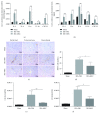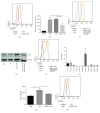Mesenchymal Stem Cells Ameliorate Hepatic Ischemia/Reperfusion Injury via Inhibition of Neutrophil Recruitment
- PMID: 30622980
- PMCID: PMC6304871
- DOI: 10.1155/2018/7283703
Mesenchymal Stem Cells Ameliorate Hepatic Ischemia/Reperfusion Injury via Inhibition of Neutrophil Recruitment
Abstract
Ischemia/reperfusion injury (IRI) remains a major problem in organ transplantation, which represents the main cause of graft dysfunction posttransplantation. Hepatic IRI is characterized by an excessive inflammatory response within the liver. Mesenchymal stem cells (MSCs) have been shown to be immunomodulatory cells and have the therapeutic action on IRI in several organs. However, the mechanism of regulatory effect of MSCs on IRI remains unclear. In the present study, we examined the impact of MSCs on hepatic inflammatory response such as neutrophil influx and liver damage in a rat model of 70% hepatic IRI. Treatment with MSCs protected rat against hepatic IRI, with significantly decreased serum levels of liver enzymes, attenuated hepatic neutrophil infiltration, reduced expression of apoptosis-associated proteins, and ameliorated liver pathological injury. MSCs also significantly enhanced the intracellular activation of p38 MAPK phosphorylation, which led to decreased expression of CXCR2 on the surface of neutrophils. In addition, MSCs significantly diminished neutrophil chemoattractant CXCL2 production by inhibiting NF-κB p65 phosphorylation in macrophages. These results demonstrate that MSCs significantly ameliorate hepatic IRI predominantly through its inhibitory effect on hepatic neutrophil migration and infiltration.
Figures





Similar articles
-
Spheroid-cultured human umbilical cord-derived mesenchymal stem cells attenuate hepatic ischemia-reperfusion injury in rats.Sci Rep. 2018 Feb 6;8(1):2518. doi: 10.1038/s41598-018-20975-0. Sci Rep. 2018. PMID: 29410537 Free PMC article.
-
Bone marrow mesenchymal stem cells ameliorate hepatic ischemia/reperfusion injuries via inactivation of the MEK/ERK signaling pathway in rats.J Surg Res. 2012 Dec;178(2):935-48. doi: 10.1016/j.jss.2012.04.070. Epub 2012 May 18. J Surg Res. 2012. PMID: 22658855
-
Repressor and activator protein accelerates hepatic ischemia reperfusion injury by promoting neutrophil inflammatory response.Oncotarget. 2016 May 10;7(19):27711-23. doi: 10.18632/oncotarget.8509. Oncotarget. 2016. PMID: 27050284 Free PMC article.
-
Gene-modified Mesenchymal Stem Cell-based Therapy in Renal Ischemia- Reperfusion Injury.Curr Gene Ther. 2017;17(6):453-460. doi: 10.2174/1566523218666180214094253. Curr Gene Ther. 2017. PMID: 29446737 Review.
-
Neutrophils--a key component of ischemia-reperfusion injury.Shock. 2013 Dec;40(6):463-70. doi: 10.1097/SHK.0000000000000044. Shock. 2013. PMID: 24088997 Review.
Cited by
-
Adipose-Derived Mesenchymal Stromal/Stem Cell Line Prevents Hepatic Ischemia/Reperfusion Injury in Rats by Inhibiting Inflammasome Activation.Cell Transplant. 2022 Jan-Dec;31:9636897221089629. doi: 10.1177/09636897221089629. Cell Transplant. 2022. PMID: 35438583 Free PMC article.
-
Role of Mesenchymal Stem/Stromal Cells in Modulating Ischemia/Reperfusion Injury: Current State of the Art and Future Perspectives.Biomedicines. 2023 Feb 23;11(3):689. doi: 10.3390/biomedicines11030689. Biomedicines. 2023. PMID: 36979668 Free PMC article. Review.
-
Mesenchymal stromal cell-dependent immunoregulation in chemically-induced acute liver failure.World J Stem Cells. 2021 Mar 26;13(3):208-220. doi: 10.4252/wjsc.v13.i3.208. World J Stem Cells. 2021. PMID: 33815670 Free PMC article. Review.
-
PDGFRα/Sca-1 Sorted Mesenchymal Stromal Cells Reduce Liver Injury in Murine Models of Hepatic Ischemia-Reperfusion Injury.Stem Cells. 2022 Nov 29;40(11):1056-1070. doi: 10.1093/stmcls/sxac059. Stem Cells. 2022. PMID: 35999023 Free PMC article.
-
Neutrophil-Induced Liver Injury and Interactions Between Neutrophils and Liver Sinusoidal Endothelial Cells.Inflammation. 2021 Aug;44(4):1246-1262. doi: 10.1007/s10753-021-01442-x. Epub 2021 Mar 1. Inflammation. 2021. PMID: 33649876 Review.
References
MeSH terms
Supplementary concepts
LinkOut - more resources
Full Text Sources

